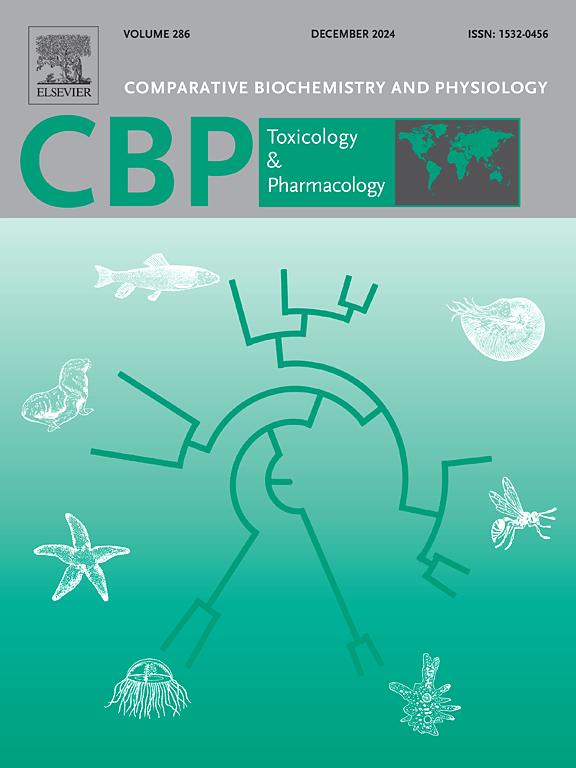调节东莨菪碱诱导大水蚤抗捕食反应的分子机制。
IF 3.9
3区 环境科学与生态学
Q2 BIOCHEMISTRY & MOLECULAR BIOLOGY
Comparative Biochemistry and Physiology C-toxicology & Pharmacology
Pub Date : 2024-12-24
DOI:10.1016/j.cbpc.2024.110116
引用次数: 0
摘要
水蚤的反捕食反应主要是由神经系统调节的,这使得这些反应特别容易受到影响神经发育或神经功能过程的化合物的影响。本研究旨在确定东莨菪碱对鱼类激素诱导的抗捕食反应的调节作用的分子途径。我们使用了两个克隆,表现出两种截然不同的反应。正致光性无性系85对鱼激素反应强烈,表现出明显的负致光性和较高的发育率。负致光性克隆F对相同的刺激表现出相反的行为。两个克隆的成虫分别暴露于鱼酮、东莨菪碱和两者的混合物中。东莨菪碱是一种蕈碱拮抗剂,能够在两种克隆中模拟鱼激素诱导的行为反应,同时影响不同的形态和生活史性状。全转录组Illumina分析表明,鱼kairomone敏感克隆85(1650)比F 1(1138)有更多的去调控基因,这些基因被分为4个簇(每个克隆2个)。东莨菪碱和鱼酮混合处理对基因转录的影响在两个无性系中呈加性,表明作用模式相似。大多数富集的代谢途径与神经通路和细胞增殖/分化调节有关。我们的研究结果表明,鱼酮和东莨菪碱不仅解除了神经信号通路,而且还解除了细胞分化和增殖通路,这与观察到的行为反应以及发育、形态和生殖效应有关。本文章由计算机程序翻译,如有差异,请以英文原文为准。

Molecular mechanisms that regulate scopolamine effects on inducible fish antipredation responses in Daphnia magna
Daphnia's antipredator responses are regulated largely by the nervous system, making these responses particularly susceptible to compounds that impact neurodevelopmental or neurofunctional processes. This study aimed to determine the molecular pathways involved in modulating the effects of scopolamine on inducible antipredation responses triggered by fish kairomones. We used two clones showing two contrasting responses. The positive phototactic clone 85 responds strongly to fish kairomones showing a marked negative phototactism and higher developmental rates. Consistently, the negative phototactic clone F shows the opposite behavior to the same stimuli. Adults of both clones were exposed to fish kairomones, scopolamine alone and a mixture of both. Scopolamine is a muscarine antagonist able to mimic fish kairomones inducible behavioral responses in both clones, while affecting differently morphological and life-history traits. Whole transcriptomic Illumina analyses indicated a greater number of de-regulated genes of the fish kairomone sensitive clone 85 (1650) compared to the F one (1138), which were grouped in four clusters (two per clone). The mixture of scopolamine and fish kairomone treatments on gene transcription was additive in both clones, indicating similar modes of action. Most enriched metabolic routes were related with neurological pathways and regulation of cell proliferation/differentiation. Our results indicate that fish kairomones and scopolamine deregulate not only neurological signaling pathways but also cell differentiation and proliferation pathways, which are linked to the observed behavioral responses as well as the developmental, morphological, and reproductive effects.
求助全文
通过发布文献求助,成功后即可免费获取论文全文。
去求助
来源期刊
CiteScore
7.50
自引率
5.10%
发文量
206
审稿时长
30 days
期刊介绍:
Part C: Toxicology and Pharmacology. This journal is concerned with chemical and drug action at different levels of organization, biotransformation of xenobiotics, mechanisms of toxicity, including reactive oxygen species and carcinogenesis, endocrine disruptors, natural products chemistry, and signal transduction with a molecular approach to these fields.

 求助内容:
求助内容: 应助结果提醒方式:
应助结果提醒方式:


